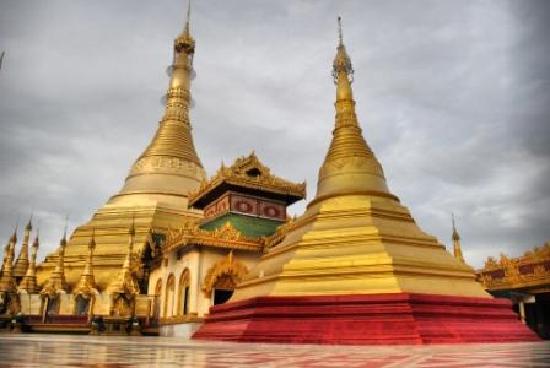
Mawlamyine (also spelled Mawlamyaing; is the fourth largest city in Myanmar after Yangon, Mandalay, and Nay Pyi Taw. situated 300 km south east of Yangon and 70 km south of Thaton. It is a major seaport situated 165 kilometers east of Yangon, across the Gulf of Mottama at the mouth of Thanlwin (Salween) river. The city of 325,927 is the capital and largest city of Mon State, Myanmar and is the main trading center and seaport in south-eastern Burma.
The Mon name for Mawlamyine, means “damaged eye.” It is said to derive from Mot-Mua-Lum, meaning “one eye destroyed”. According to legend, a Mon king had a powerful third eye in the centre of his forehead, able to see what was happening in neighbouring kingdoms. The daughter of one of the neighbouring kings was given in marriage to the three-eyed king and managed to destroy the third eye. The Burmese name “Mawlamyine” is believed to be a corruption of the Mon name.
Mawlamyine is off the main tourist trail for most travelers to Myanmar, but the town does have a charm of its own. Once known as “Little England”, due to its large Anglo-Burmese community, Mawlamyaing has a rich history. Buildings with colonial style architecture, and its close proximity to the infamous Siam-Burma “death railway”, making it a fascinating place.
Three famous pagodas adorn the Mawlamyine Ridge.
The Kyaik-thanlan pagoda was erected in 875 A.D. during the reign of King Mutpi Raja. A hair relic of the Buddha. Tripitaka manuscripts and gold images of the Buddha were enshrined in the pagoda as well as a tooth relic conveyed from Sri Lanka by a delegation of monks. Successive kings raised the pagoda higher, from 56 feet to the present 150 feet. The present base of the pagoda is 450 feet in circumference. There are 34 small pagodas called Zediyan surrounding the pagoda. A lift has now been installed for easy access. Kyaik in Mon language means a Cedi or Stupa The pagoda was repaired by King Anawrahta, founder of the Bagan Dynasty, and later enlarged by Mon kings, especially King Wagaru of Mottama in 1538 A.D. On the Platform can be seen a big bell with a medieval Mon inscription and also another bell with a quaint inscription in English, dated 30th March 1885: “This bell made by Koonalenga, the priest, and weight 500 viss. No one body design to destroy this bell." There is also a memorial to the famous Thingaza Sayadaw who passed away in Mawlamyine in 1900.
U Zina pagoda is named after a person called U Zina, but no one really knows who he was. Some say that U Zina was a sage who lived at thc time of king Asoka, and that U Zina was just a villager who while collecting shoots on the hill where the pagoda now stands, found a pot of gold buried in a bamboo grove. The villager and his wife became rich and built this pagoda on the hill which gave up its treasure to them. The old Mon name for this pagoda is Kyaikpatan, named after thc white hill on which it stands. Legend says it was first built in the 3rd century B.C. There is a reclining Buddha Image. Visitors should also see the four life-like figures. a decrepit old man leaning on a staff. a man suffering from a loathsome disease. a putrid corpse and finally a monk in yellow robes free from all worldly cares. These four figures represent the four signs that made Lord Buddha leave the palace for the life of a religious recluse.
Maha Muni Pagoda is a replica of the Maha Muni Image at Mandalay. The Seindon Mibaya-gyi. a prominent Queen of King Mindon from Mandalay, went to live mawlamyine after the Annexation. She and other members of the Myanmar Royal Family who were in Mawlamyine, felt a great longing to pay homage to the Maha Muni Image, and they arranged for a replica to be made in 1904. The building of this Pagoda was led by Sayadaw Waziya-yama, a prominent Buddhist monk, and Daw Shwe Bwin of Mawlamyine. The great image made in Mandalay was brought to Naga-with a Hill on the Mawlamyine Ridge, where a large building, a Gandakudi Taik, was erected to house it. The nearby monastery named after its donor, the Seindon Mibaya kyaung has some excellent wood-carvings which are over a hundred years old.
Win Sein Reclining Buddha at Mudon is 29 km south of Mawlamyine and is the world's largest reclining Buddha at Mudon. The Buddha Image is named as Zinathuka Yan Aung Chantha, which has a length of 400 feet (180 m), and inside the image are 182 rooms in 8 storeys. It has the height of 110 feet (nearly 34 m). Near to the image, 200 standing monks collecting alms Images can be seen clearly. It is approached by a roadway with 500 lifesize statues of Arahant disciples of Buddha and a hall whose chamber walls display scenes of Buddha's lifetime, and the underworld.

Myanmar Interlink Services Travel & Tour @2025.Developed by Digital Dots
